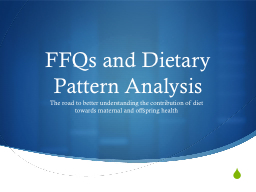

The road to better understanding the contribution of diet towards maternal and offspring health Diet and Health Incident of Diabetes IDF 2013 Diet and Health Incident of Diabetes IDF 2013 Diet and Health ID: 1030399
Download Presentation The PPT/PDF document "FFQs and Dietary Pattern Analysis" is the property of its rightful owner. Permission is granted to download and print the materials on this web site for personal, non-commercial use only, and to display it on your personal computer provided you do not modify the materials and that you retain all copyright notices contained in the materials. By downloading content from our website, you accept the terms of this agreement.
1. FFQs and Dietary Pattern AnalysisThe road to better understanding the contribution of diet towards maternal and offspring health
2. Diet and HealthIncident of Diabetes, IDF 2013
3. Diet and HealthIncident of Diabetes, IDF 2013
4. Diet and HealthkCal per day, 2014
5. Diet and Health
6. Uncover food patterns associated with increased and reduced incidence of disease, their biomarkers (e.g., body weight), and/or their internal regulators (e.g., gene expression).Using:Food Frequency Questionnaires (FFQs); andDiet pattern analysis using Principal Component Analysis (PCA).Diet and Health
7. Dietary AnalysisFFQs are questionnaires used to determine the food and beverages, and their quantities, consumed by an individual;For the NutriGen study, FFQs from each of the four cohorts (ABC, CHILD, FAMILY, and START) have been processed.
8. Dietary AnalysisFFQs are questionnaires used to determine the food and beverages, and their quantities, consumed by an individual;For the NutriGen study, FFQs from each of the four cohorts (ABC, CHILD, FAMILY, and START) have been processed.
9. Dietary AnalysisSHARE (ABC, FAMILY, and START)CHILDOriginMcMaster (Kelemen LE, et al., 2003) and the Food Processor nutrient analysis softwareFred Hutchinson Cancer Research Center and Nutrition Data Systems for ResearchItems~160 (variation between ethnicities)~150Food GroupingNOYES (e.g., doughnuts, pies, pastries)Ethnic- SpecificYES (White European, South Asian, Chinese, and Aboriginal/First Nation)NOConsumption FrequencySelf-definedRanged (e.g., 1-2x/week)Serving SizeEqual between ‘SHARE’ studiesSome differences with ‘SHARE’
10. SHARE (ABC, FAMILY, and START)CHILDOriginMcMaster (Kelemen LE, et al., 2003) and the Food Processor nutrient analysis softwareFred Hutchinson Cancer Research Center and Nutrition Data Systems for ResearchItems~160 (variation between ethnicities)~150Food GroupingNOYES (e.g., doughnuts, pies, pastries)Ethnic- SpecificYES (White European, South Asian, Chinese, and Aboriginal/First Nation)NOConsumption FrequencySelf-definedRanged (e.g., 1-2x/week)Serving SizeEqual between ‘SHARE’ studiesSome differences with ‘SHARE’Dietary AnalysisRequires standardization
11. Dietary Pattern AnalysisStandardize CHILD food portions to that of the SHARE FFQ.e.g., ½ cup versus 1 cup servings, change from 2/week to 1/week
12. Dietary Pattern AnalysisStandardize CHILD food portions to that of the SHARE FFQ.e.g., ½ cup versus 1 cup servings, change from 2/week to 1/weekCreate standard food groups to reduce number of variables and ease interpretation of dietary patterns e.g., canned meat lunch meat, breakfast sausages => processed meat
13. Dietary Pattern Analysis*Hu et al AJCN 1998, Fung et al AJCN 2001, Nettleton et al AJCN 2009, Gadgil et al JAND 2013.Standardize CHILD food portions to that of the SHARE FFQ.e.g., ½ cup versus 1 cup servings, change from 2/week to 1/weekCreate standard food groups to reduce number of variables and ease interpretation of dietary patterns e.g., canned meat lunch meat, breakfast sausages => processed meatBuilt upon food groupings from previous studies* analyzing dietary pattern analysis and cardiometabolic conditions, allergies, and indicators (e.g., FPG, HOMA-IR, CRP, cholesterol and TG).
14. SnacksSweetsCondimentsSweet DrinksArtificial SweetTeaCoffeeCoolers, Spirits, and Mixed DrinksFull-Fat DairyLow-Fat DairyFermented DairyMeatsMeat DishesOrgan MeatsProcessed MeatsPoultry & Waterfowl EggsFish & SeafoodLeafy GreensCruciferous VegetablesStarchy VegetablesVegetable MedleyOther VegetablesFresh SeasoningsLegumesTofuFruitsNon-Meat DishesStir-Fried Noodles and RiceRefined GrainsPastaPizzaFrench FriesWhole GrainsNuts and Seeds FatsFried FoodsDietary Pattern Analysis
15. Principal Component Analysis (PCA)Reduces complex data into fewer dimensionsAre there underlying patterns that distinguish groups of individuals?e.g., dietary patternPerformed in R, using ‘psych’ packageTo uncover that we need to consider three PCA parameters:Number of dimensions/factors (i.e., number of diet patterns)Rotation method (i.e., diet patterns)Loading scores (i.e., foods within each diet)Dietary Pattern Analysis
16. Scree plot (“breakpoint” or “breakpoint” -1)Arbitrary cutoff (e.g., eigenvalue of 1.0)Dietary Analysis 1. Number of Dimensions
17. Groups the data in a specified manner, that best tells the storyOblique - assume that the variables are correlatedOrthogonal - assume that the variables in the analysis are uncorrelatedMultiple choices but ‘varimax’ is most common dietary analysisAims to load food strongly in one dimension only.Dietary Analysis 2. Rotation Method
18. Dietary Analysis 3. Loading ScoresHow strongly a specific food item/group contributes to a dimension/dietary patternTypical cutoff range from 0.20-0.30.In this case, 0.30 was used as the cutoff as it provided a clear contrast between dietary patterns (e.g., prudent and Western)
19. ABCWesternPrudentWestern: Red meats, processed meats, fried foods, refined grains, snacks, pasta, pizza, french fries, sweets and condiments.Prudent: Red meats, seafood, non-red meats, legumes, leafy greens, fruit and vegetables.
20. CHILDWesternPrudentPrudent: Non-red meats, legumes, leafy greens, fruit, vegetables, non-meat dishes.Western: Fats, processed meats, fried foods, refined grains, , pasta, pizza, french fries, snacks, sweets and condiments.
21. FAMILYWesternPrudentPrudent: Fermented dairy, non-red meats, legumes, leafy greens, fruit, vegetables, whole grains, non-meat dishes.Western: Fats, red-meat, processed meats, fried foods, refined grains, pasta, pizza, french fries, snacks, sweets and condiments.
22. STARTWesternPrudentPrudent: Low-fat dairy, fermented dairy, legumes, fruit, vegetables, non-meat dishes.Western: Full fat dairy, red-meat, processed meats, fried foods, refined grains, snacks, sweets and condiments.
23. NutriGenPollo-pescetarianWesternPrudentPrudent: Fermented dairy, legumes, fruit, vegetables, non-meat dishes.Western: Full-fat dairy, red-meat, processed meats, starchy vegetables, refined grains, pasta, pizza, french fries, snacks, sweets and condiments.Pollo-pescetarian: Eggs, fish, poultry, leafy greens, fruit, vegetables, stir-fried dishes, nuts and seeds.
24. Next StepsCompare loading scores to maternal outcomes such as GWG, GDM status, FPG, and AUC glucose.If associations uncovered, does the diet also contribute to the health of the offspring.
25.
26. K-means (2 clusters)
27. AUC = 0.988K-means (2 clusters)PCA Scores vs K-means Classification